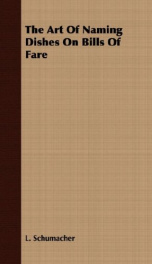the art of naming dishes on bills of fare

THE ART OF NAMING DISHES on BILLS OF FARE By L. SCHUMACHER Preface This little work is written for the progressive element in the hotel and restaurant profession because of the fact that the menus and bills of fare are, to a great extent, neither intelligible to the server nor the served. Therefore, a method of naming dishes will be offered in the following pages, which I hope will be satisfactory to all concerned proprietors, employees and guests. There is no doubt that this way of naming dishes is the only effective method of reforming and doing away with the medly that now generally exists. It must be understood that a plain and intelligible menu and bill of fare is exactly the same as an attractive advertisement and has the same value of silent salesmanship. The author is sure that the system, if carried out, will also avoid most of the food waste which now occurs, because it eliminates the sending back of dishes by guests and the spoiling of goods in stock. This, on account of the many patrons who order without knowledge of what the names of dishes represent and inversely there aremany dishes which have names unintelligible to guests and therefore are not ordered. In particular table dhote dinners would not have the immense waste, and many millions which are now lost could be saved. Next to these advantages, there are others which should not be underestimated. Waiters, waitresses, etc., will be relieved of the study regarding names of dishes which, as at present, can never be studied to perfection because the medly is too great. The attendants will have to deal with only such names as are plain and intelligible to everybody. This will make them better waiters, and in a shorter time. Translators will have much easier work. Instead of going through a thick volume, the necessary culinary names in several languages can be given in a booklet of a size that fits the waistcoat pocket, because all style names in style, a la which makes the culinary languages so confusing and difficult, are considered as secondary, and the waiter or waitress does not need to bother with them, when the principle ingredients and kinds of preparations are given. This work also is a precursor of a series of culinary cyclopeadical dictionaries which will be published in six volumes English - French and French - English English - Spanish and Spanish - English. English - German and German - French - Spanish and Spanish - French. French. - German and German - French. Spanish - German and German - English. Spanish. That this little work may contribute to greater clarity and simplicity is the main desire of the writer, because in the naming of dishes there is so much to be improved which would be mutually beneficial. NEW YORK CITY THE AUTHOR Contents Preface 5 Key to the Signs - 8 Intelligible and Unintelligible Names of Dishes 9 Advantages of having Intelligible Names on Bills of Fare 9 Instances 12 Short Names 16 Names that are too long 19 Rules for the Naming of Dishes 20 ForeignNames on English Menus and Bills of Fare 21 Are Foreign Names of Dishes easily understood 29 Are all Domestic Names Understood 32 Bills of Fare in more than one language 34 The Abbreviation of Names 62 The Meaning of the Personal Nouns, Geographical Names, Titles, etc ... 69 Style Designations 76 Concluding Words, Mainly for the Compilers of the Bills of Fare ..... 106 Rules of Grammar of Four Languages The Using of Adjectives List of Adjectives 115 ...
Info about the book
Author:
Series:
Unknown
ASIN:
B007PMNYXG
Rating:
5/5 (4)Your rating:
0/5
Languge:
English
Users who have this book
Users who want this book
What readers are saying
What do you think? Write your own comment on this book!
write a commentGenre
if you like the art of naming dishes on bills of fare try:
Other books by this author
Do you want to exchange books? It’s EASY!
Get registered and find other users who want to give their favourite books to good hands!

